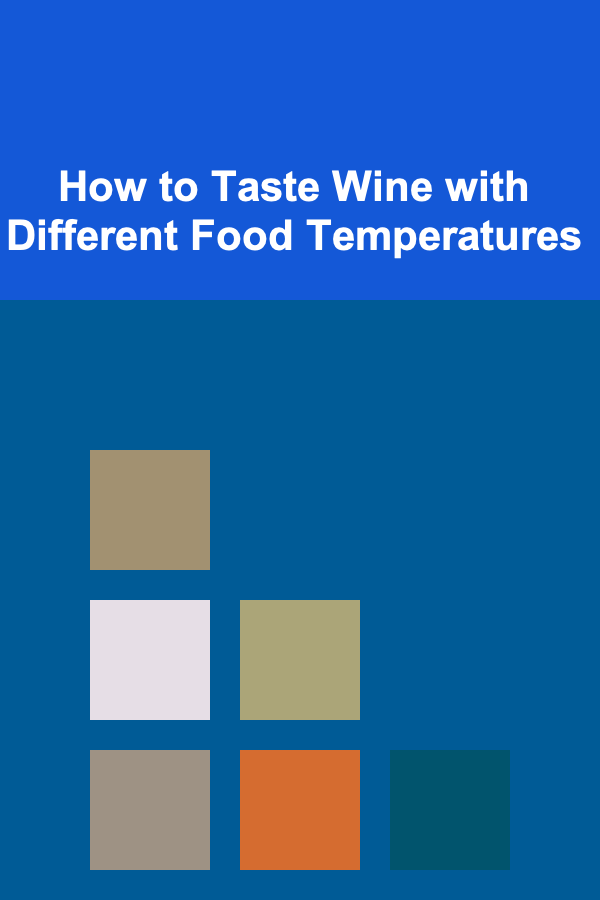
How to Taste Wine with Different Food Temperatures
ebook include PDF & Audio bundle (Micro Guide)
$12.99$11.99
Limited Time Offer! Order within the next:

Wine tasting is an art, one that involves the careful interplay of sensory experiences, from the sight of the wine to its aroma, flavor, and texture. A key element that can significantly influence how a wine is perceived is the temperature at which both the wine and the food are served. The right combination of wine temperature and food temperature can enhance or diminish the tasting experience. In this article, we will explore the nuanced relationship between wine, food, and temperature and how it affects the overall tasting experience.
The Science of Temperature in Wine Tasting
The temperature of both wine and food affects their chemical composition and the way they interact on the palate. Wine contains volatile compounds, like esters and aldehydes, which give it its aromas. Temperature plays a vital role in the release of these compounds, affecting the intensity of the aroma and the perception of the wine's flavors.
- Low temperatures tend to suppress the release of these compounds, making the wine seem less aromatic. On the other hand, higher temperatures enhance the volatility of these compounds, often making the wine appear more aromatic, but it can also exaggerate certain characteristics, like alcohol or tannin bitterness.
- Food temperature also plays a role in this dynamic. Warm foods may release more aromatic compounds, which can overpower the subtleties of a wine's aroma if not balanced correctly. Cold foods, conversely, may suppress the flavor experience, making it harder to perceive the wine's nuances.
Thus, finding the right temperature for both wine and food is critical for a balanced and enjoyable tasting experience.
The Role of Wine Temperature
Before diving into food pairing, it's important to understand how the temperature of wine impacts the tasting experience.
Red Wine Temperature
Red wines are typically served at a slightly warmer temperature than white wines. The optimal serving temperature for red wines is usually between 16°C to 18°C (60°F to 65°F). This range allows the aromas and flavors to fully develop without overwhelming the senses.
- Too cold: When red wine is too cold (below 16°C), the tannins in the wine may become more prominent, making the wine taste overly astringent. The fruitiness and complexity of the wine will also be subdued.
- Too warm: On the other hand, when red wine is served too warm (above 18°C), the alcohol in the wine becomes more noticeable, which can lead to a hot, overly alcoholic taste. The fruitiness may become too jammy, and the wine can feel unbalanced.
White Wine Temperature
White wines, which typically have lighter structures and more delicate flavors than red wines, are best served slightly chilled. The optimal temperature for white wines is usually between 8°C to 12°C (46°F to 54°F).
- Too cold: If white wine is served too cold, below 8°C, the flavors will be too muted. The acidity and freshness may still shine through, but the complexity of the wine will be difficult to appreciate.
- Too warm: If the white wine is served too warm (above 12°C), the wine's acidity can be less pronounced, and the fruit flavors may become flabby or lose their crispness.
Sparkling Wine Temperature
Sparkling wines, including Champagne, are generally best served colder than both red and white wines, typically between 6°C to 8°C (42°F to 46°F). This cool temperature helps preserve the bubbles and maintain a refreshing crispness.
- Too cold: However, serving sparkling wine too cold can suppress its aromas and flavors, resulting in a less enjoyable tasting experience.
- Too warm: Similarly, serving sparkling wine too warm can cause the bubbles to dissipate too quickly, leading to a flat, less refreshing texture.
Dessert Wine Temperature
Dessert wines, such as Port or Sauternes, are best served slightly chilled (around 12°C to 14°C or 54°F to 57°F) but warmer than white wines to allow the sweetness and complexity to come forward.
- Too cold: Serving dessert wine too cold will mask the sweetness and other rich flavors, making it seem thin and less flavorful.
- Too warm: Serving dessert wine too warm can make the sweetness overwhelming, diminishing the subtleties of the wine.
The Impact of Food Temperature
Food temperature plays an equally important role in pairing with wine. When food is served too hot or too cold, it can overwhelm or suppress the flavors of the wine, leading to a mismatch.
Hot Food Temperature
Hot foods generally release more volatile compounds, which can overpower delicate wines. However, pairing a hot dish with a wine at the right temperature can create a harmonious balance.
- Red wines with hot food: Rich, full-bodied red wines like Cabernet Sauvignon, Syrah, or Zinfandel are well-suited to hot, hearty dishes like grilled meats or stews. The warmth of the food will enhance the flavor of the wine without overpowering it. The wine's tannins and acidity work well with the richness of hot dishes.
- White wines with hot food: Lighter white wines like Sauvignon Blanc, Pinot Grigio, or Chardonnay can pair well with slightly hot foods like grilled chicken, seafood, or pasta dishes with cream sauce. These wines' acidity and crispness complement the heat and richness of the food.
- Sparkling wines with hot food: Sparkling wines can also be great with hot food, especially when serving appetizers like fried food or dishes with a crunchy texture. The effervescence of the wine helps cleanse the palate, balancing the richness and grease from the hot food.
Cold Food Temperature
Cold foods, on the other hand, tend to suppress the release of aromatic compounds, which may make it difficult to perceive the full potential of the wine. However, cold dishes can work well with wines served at a slightly colder temperature.
- Red wines with cold food: Lighter red wines like Pinot Noir or Gamay are ideal with cold foods, such as cold cuts or salads. These wines have a delicate profile that complements cold dishes without overwhelming them.
- White wines with cold food: Cold dishes like sushi, fresh salads, or chilled seafood pair excellently with white wines served at their optimal temperature. A chilled Sauvignon Blanc, Albariño, or Riesling can complement the fresh, light flavors of the food without overpowering them.
- Sparkling wines with cold food: Sparkling wines are often a natural choice for cold foods like seafood platters, oysters, or cheese boards. The crispness and acidity of sparkling wines, when served cold, balance the richness and refreshing quality of cold foods.
Pairing Wine and Food with Different Temperatures
Once you have an understanding of how both wine and food temperatures influence each other, it's time to explore some practical pairings.
Warm Red Wines with Hearty Dishes
- Cabernet Sauvignon with a warm steak: The tannins in Cabernet Sauvignon complement the protein and fat in steak, creating a robust flavor pairing.
- Syrah/Shiraz with warm barbecued meats: The smoky, spicy notes of Syrah pair beautifully with grilled meats, balancing the richness of the dish with the wine's complexity.
Chilled White Wines with Light Dishes
- Sauvignon Blanc with a chilled goat cheese salad: The high acidity and herbal notes of Sauvignon Blanc cut through the creaminess of goat cheese and enhance the freshness of a green salad.
- Chardonnay with warm lobster or crab: A fuller-bodied white like Chardonnay, with a touch of oak, pairs well with buttery lobster or crab, complementing the richness of the seafood.
Sparkling Wines with Both Hot and Cold Foods
- Champagne with fried foods: The crispness of Champagne cuts through the oiliness of fried foods, creating a balanced contrast in textures and flavors.
- Prosecco with chilled sushi: Prosecco's light, crisp bubbles complement the delicate flavors of sushi, enhancing the overall experience.
Dessert Wines with Rich Desserts
- Port with warm chocolate cake: The rich, sweet character of Port balances the intensity of a warm chocolate dessert, making it a luxurious pairing.
- Sauternes with chilled fruit tarts: The honeyed sweetness of Sauternes enhances the tart, tangy flavor of fruits in a chilled tart, creating a beautifully harmonious dessert experience.
Final Thoughts
Temperature is one of the most important factors in wine tasting, influencing both the wine's characteristics and how it interacts with food. The ideal pairing is a delicate balance where both the wine and the food complement each other, and their temperatures enhance the sensory experience.
When pairing wine with food, always consider both the temperature of the wine and the temperature of the dish. The right wine at the right temperature can elevate the food, and the right food at the right temperature can unlock the full potential of the wine. Experiment with different combinations, and don't be afraid to trust your own palate to find the perfect match. Whether you're serving a rich red wine with a hearty steak or a delicate white with fresh seafood, understanding the role of temperature in the tasting experience will help you create memorable and enjoyable pairings every time.
Reading More From Our Other Websites
- [Personal Care Tips 101] How to Get a Whiter Smile in Just 30 Minutes with Teeth Whitening Strips
- [Home Staging 101] How to Stage Your Home with Temporary Changes
- [Personal Care Tips 101] How to Choose Teeth Whitening Strips That Fit Your Lifestyle
- [Home Holiday Decoration 101] How to Decorate Your Home Office for the Holiday Season
- [Personal Care Tips 101] How to Create a Personalized Facial Steaming Routine for Different Skin Types
- [Home Maintenance 101] How to Clean and Maintain Your Home's Kitchen Exhaust Fan
- [Metal Stamping Tip 101] From Zinc to PVD: Comparative Review of Modern Metal Stamping Coating Technologies
- [Gardening 101] Eco‑Smart Soil: Building Nutrient‑Rich, Chemical‑Free Beds with Organic Amendments
- [Home Holiday Decoration 101] How to Curate the Perfect Christmas Music Playlist for a Festive Atmosphere
- [Home Holiday Decoration 101] How to Hang Christmas Lights Like a Pro for a Gorgeous Display

How to Handle Seasonal Allergies with Cleaning
Read More
How to Prepare Your Antique Collection for Sale
Read More
How to Use Magnetic Strips for Small Metal Items
Read More
How to Experience the Art and History of St. Petersburg
Read More
How to Plan a Web Design Project for eCommerce Businesses
Read MoreHow to Use a Car Maintenance Expense Tracker to Prevent Costly Repairs
Read MoreOther Products

How to Handle Seasonal Allergies with Cleaning
Read More
How to Prepare Your Antique Collection for Sale
Read More
How to Use Magnetic Strips for Small Metal Items
Read More
How to Experience the Art and History of St. Petersburg
Read More